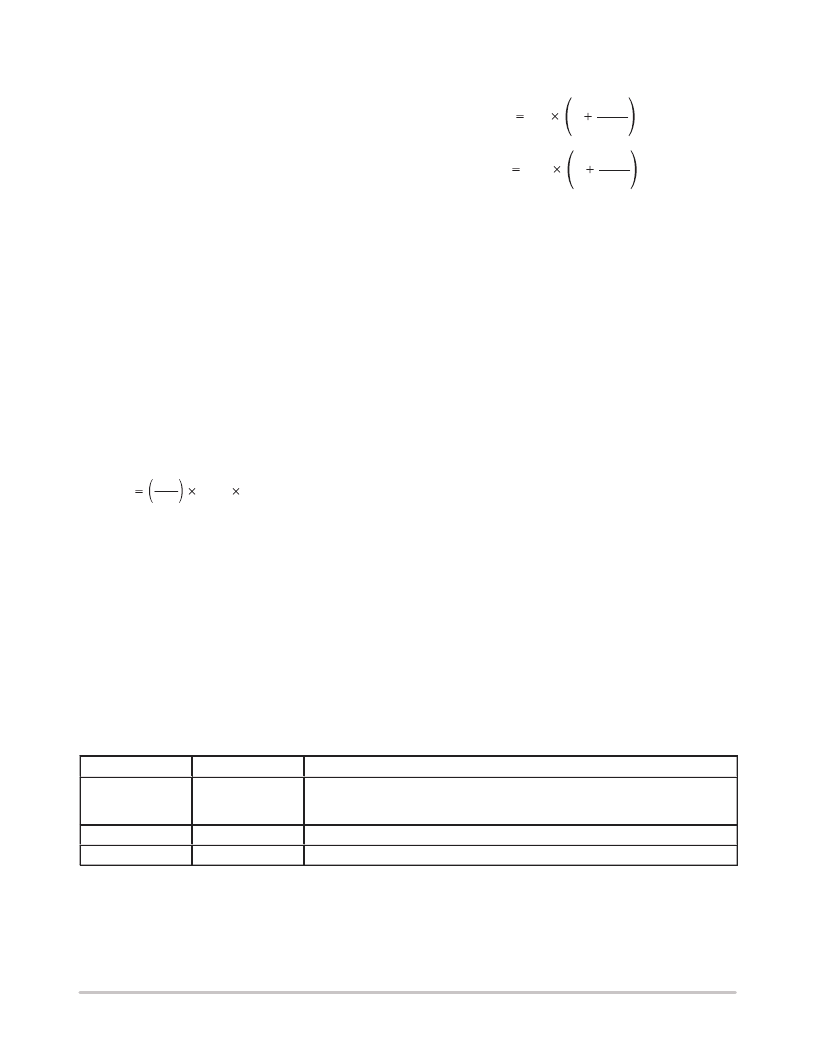- 您現(xiàn)在的位置:買賣IC網(wǎng) > PDF目錄382304 > MC33680FTB (ON SEMICONDUCTOR) Single Output LDO, 400mA, Fixed(2.85V), Low Noise, Fast Transient Response 8-MSOP -40 to 85 PDF資料下載
參數(shù)資料
| 型號(hào): | MC33680FTB |
| 廠商: | ON SEMICONDUCTOR |
| 元件分類: | 穩(wěn)壓器 |
| 英文描述: | Single Output LDO, 400mA, Fixed(2.85V), Low Noise, Fast Transient Response 8-MSOP -40 to 85 |
| 中文描述: | 1.15 A DUAL SWITCHING CONTROLLER, 100 kHz SWITCHING FREQ-MAX, PQFP32 |
| 封裝: | PLASTIC, LQFP-32 |
| 文件頁數(shù): | 13/16頁 |
| 文件大?。?/td> | 340K |
| 代理商: | MC33680FTB |

MC33680
http://onsemi.com
13
DETAILED OPERATING DESCRIPTION (Cont’d)
Current Limit for Both regulators
From Figure 18 and Figure 21, sense devices (senseFET
or senseBJT) are applied to sample coil current as the
low–side switch is ON. With that sample current flowing
through a sense resistor, sense–voltage is developed.
Threshold detector (COMP2 in both Figures) detects
whether the sense–voltage is higher than preset level. If it
happens, detector output reset the flip–flop to switch OFF
low–side switch, and the switch can only be ON as next
cycle starts.
Power–Good Signal
During the startup period (see Figure 2), the internal
startup circuitry is enabled to pump up VMAIN to a certain
voltage level, which is the user–defined VMAIN output
level minus an offset of 0.15V. The internal Power–Good
signal is then enabled to activate the main regulator and
conditionally the auxiliary regulator. Meanwhile, the startup
circuitry will be shut down. The Power–Good signal block
also starts to charge up the external capacitor tied from Pin
PDELAY to ground with precise constant current. As the Pin
PDELAY’s voltage reaches an internal set threshold, Pin
PORB will go HIGH to awake the microprocessor. This
delay is stated as follows;
TPOR
1.22
0.5
Cpor
RIref (S)
From Figure 3, if, by any chance, VMAIN is dropped
below the user–defined VMAIN output level minus 0.5V,
PORB will go LOW to indicate the OUTPUT LOW
situation. And, the IC will continue to function until the
VMAIN is dropped below 2V.
Low–Battery–Detect
The Low–Battery–Detect block is actually a voltage
comparator. Pin LOWBAT is LOW, if the voltage of external
Pin LOWBATSEN is lower than 0.85V. The IC will neglect
this warning signal. Pin LOWBAT will become HIGH, if the
voltage of external Pin LOWBATSEN is recovered to more
than 1.1V. From Figure 1, with external resistors RLBa and
RLBb, thresholds of Low–Battery–Detect can be adjusted
based on the equations below.
VLOBAThigh
1.1
1
RLBa
RLBb
(V)
VLOBATlow
0.85
1
RLBa
RLBb
(V)
Lithium–Battery backup
The backup conduction path which is provided by an
internal power switch (typ. 13 Ohm) can be controlled by
internal logic or microprocessor.
If LIBATCL is LOW, the switch, which is then controlled
by internal logic, is ON when the battery is removed and
VMAIN is dropped below LIBATIN by more than 100mV,
and returns OFF when the battery is plugged back in.
If LIBATCL is HIGH, the switch is controlled by
microprocessor through LIBATON. The truth table is shown
in Figure 22.
Efficiency and Output Ripple
For both regulators, when large values are used for
feedback resistors (> 50kOhm), stray capacitance of pin 1
(VMAINFB) and pin 20 (VAUXFBN) can add ”lag” to the
feedback response, destabilizing the regulator and creating
a larger ripple at the output. From Figure 1, ripple of Main
and AUX regulator can be reduced by capacitors in parallel
with RMAINb, RAUXa and RAUXb ranging from 100pF to
100nF respectively. Reducing the ripple is also with
improving efficiency, system designers are recommended to
do experiments on capacitance values based on the PCB
design.
Bypass Capacitors
If the metal lead from battery to coils are long, its stray
resistance can put additional power loss to the system as AC
current is being conducted. In that case, bypass capacitors
should be placed closely to the coil, and connected from
VBAT to ground. This reduces AC component of coil current
passing through the long metal lead, thus minimizing that
portion of power loss.
LIBATCL
LIBATON
Action
ááááááááááááááááááááááááááááááá
á
á
ááááááááááááááááááááááááááááááá
ááááááááááááááááááááááááááááááá
ááááááááááááááááááááááááááááááá
ááááá
ááááá
0
á
á
áááá
áááá
X
á
á
The switch is OFF when the battery is plugged in.
áááááááááááááááááááá
áááááááááááááááááááá
á
á
Figure 22. Lithium Battery Backup Control Truth Table
相關(guān)PDF資料 |
PDF描述 |
|---|---|
| MC33765DTB | Very Low Dropout/Ultra Low Noise 5 Outputs Voltage Regulator |
| MC33765DTBR2 | Very Low Dropout/Ultra Low Noise 5 Outputs Voltage Regulator |
| MC33887 | 5.0 A H-Bridge with Load Current Feedback |
| MC33887DH | 5.0 A H-Bridge with Load Current Feedback |
| MC33887DHR2 | 5.0 A H-Bridge with Load Current Feedback |
相關(guān)代理商/技術(shù)參數(shù) |
參數(shù)描述 |
|---|---|
| MC33680FTBR2 | 功能描述:IC REG BST SYNC ADJ 0.2A 32LQFP RoHS:否 類別:集成電路 (IC) >> PMIC - 穩(wěn)壓器 - DC DC 開關(guān)穩(wěn)壓器 系列:- 產(chǎn)品培訓(xùn)模塊:Lead (SnPb) Finish for COTS Obsolescence Mitigation Program 標(biāo)準(zhǔn)包裝:1 系列:- 類型:降壓(降壓) 輸出類型:固定 輸出數(shù):1 輸出電壓:3.3V 輸入電壓:4.5 V ~ 24 V PWM 型:- 頻率 - 開關(guān):- 電流 - 輸出:125mA 同步整流器:無 工作溫度:-40°C ~ 85°C 安裝類型:表面貼裝 封裝/外殼:SOT-23-6 包裝:Digi-Reel® 供應(yīng)商設(shè)備封裝:SOT-6 其它名稱:MAX1836EUT33#TG16DKR |
| MC33689DDWB | 功能描述:CAN 接口集成電路 SBCLIN RoHS:否 制造商:Texas Instruments 類型:Transceivers 工作電源電壓:5 V 電源電流: 工作溫度范圍:- 40 C to + 85 C 封裝 / 箱體:SOIC-8 封裝:Tube |
| MC33689DDWBR2 | 功能描述:CAN 接口集成電路 SBCLIN RoHS:否 制造商:Texas Instruments 類型:Transceivers 工作電源電壓:5 V 電源電流: 工作溫度范圍:- 40 C to + 85 C 封裝 / 箱體:SOIC-8 封裝:Tube |
| MC33689DPEW | 制造商:Freescale Semiconductor 功能描述:SYSTEM BASIS CHIP W/LIN 制造商:Freescale Semiconductor 功能描述:SYSTEM BASIS CHIP W/LIN - Bulk 制造商:Freescale Semiconductor 功能描述:IC SYSTEM BASIS W/LIN 32SOIC |
| MC33689DPEWR2 | 制造商:Freescale Semiconductor 功能描述:SYSTEM BASIS CHIP W/LIN 制造商:Freescale Semiconductor 功能描述:SYSTEM BASIS CHIP W/LIN - Tape and Reel 制造商:Freescale Semiconductor 功能描述:IC SYSTEM BASIS W/LIN 32SOIC |
發(fā)布緊急采購,3分鐘左右您將得到回復(fù)。